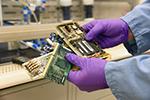
Every year, it takes millions of gallons of water to clean, peel and slice Idaho's potatoes before they're processed into any number of products from tater tots and animal feed to industrial starch. As a result, Idaho potato processors must treat and dispose of a large amount of wastewater that contains organic matter, silt and sand.
But now new research from Idaho National Laboratory suggests that potato wastewater might serve well as a low-cost food source for a special bacterium that could be used to recycle high-tech devices, industrial catalysts and other sources of rare earth elements.
The research was funded through the Critical Materials Institute. See the full story at Potato News Today, here
